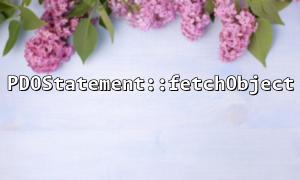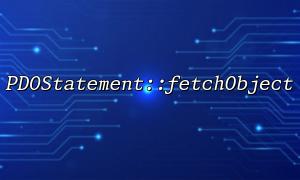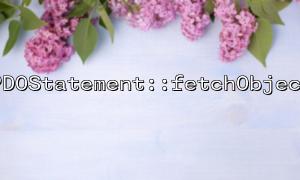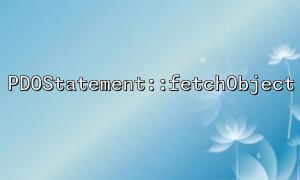In PHP database development, PDOStatement::fetchObject is a very practical method that can directly map query results into objects. If PHP's reflection mechanism is combined, a more flexible and dynamic data access mode can be further realized. This article will explain in detail how to do this and give practical examples.
Generally, fetchObject can directly convert a row of query results into an instance of a specified class. For example:
<?php
$pdo = new PDO('mysql:host=localhost;dbname=testdb', 'user', 'password');
$stmt = $pdo->query('SELECT id, name, email FROM users');
$user = $stmt->fetchObject('User');
If the User class defines public attributes such as id , name , and email , PDO will automatically assign values.
But when our class structure is complex, such as if we need to pass parameters in the constructor, or the properties are private, simply using fetchObject is not flexible enough.
PHP's reflection mechanism allows us to check the properties, methods of classes, and even dynamically instantiate objects at runtime, which gives us a lot of room for operation.
<?php
class User
{
private int $id;
private string $name;
private string $email;
public function __construct(int $id, string $name, string $email)
{
$this->id = $id;
$this->name = $name;
$this->email = $email;
}
public function getProfileUrl(): string
{
return 'https://gitbox.net/user/' . $this->id;
}
}
// Create a database connection
$pdo = new PDO('mysql:host=localhost;dbname=testdb', 'user', 'password');
$stmt = $pdo->query('SELECT id, name, email FROM users');
// Get query results
while ($row = $stmt->fetch(PDO::FETCH_ASSOC)) {
$reflectionClass = new ReflectionClass(User::class);
$user = $reflectionClass->newInstanceArgs([
(int)$row['id'],
(string)$row['name'],
(string)$row['email']
]);
echo $user->getProfileUrl() . PHP_EOL;
}
In this example, ReflectionClass::newInstanceArgs allows us to directly pass array parameters to create objects, no longer relying on direct assignment of public properties. This approach can deal with more complex construction needs.
In order to improve code reuse, we can encapsulate the above logic into a general function:
<?php
function fetchAllAsObjects(PDOStatement $stmt, string $className): array
{
$results = [];
$reflectionClass = new ReflectionClass($className);
while ($row = $stmt->fetch(PDO::FETCH_ASSOC)) {
$object = $reflectionClass->newInstanceArgs(array_values($row));
$results[] = $object;
}
return $results;
}
// Example of usage
$stmt = $pdo->query('SELECT id, name, email FROM users');
$users = fetchAllAsObjects($stmt, User::class);
foreach ($users as $user) {
echo $user->getProfileUrl() . PHP_EOL;
}
Notice:
To ensure that the column order of the query results is consistent with the constructor parameter order, additional processing is required.
For more complex situations, parameter binding can be finely controlled through ReflectionMethod .
When using Reflection , be sure to pay attention to performance, especially in large amounts of data processing, ReflectionClass instances should be cached as much as possible.
If the column name and class attribute are inconsistent, a column-to-parameter mapping is required. At this time, further encapsulation can be further encapsulated, such as adding the correspondence between parameter name and column name.
If you use this pattern extensively in your application, consider combining automatic mapping libraries such as AutoMapper or developing a small ORM tool.
By combining PDOStatement::fetchObject and reflection mechanism, we can easily convert database query results into complex objects, reducing a large amount of repeated assignment code, and improving the scalability and maintenance of the project. If you want to learn more in-depth practices, you can visit https://gitbox.net/blog/pdo-reflection-example .
Related Tags:
PDOStatement














